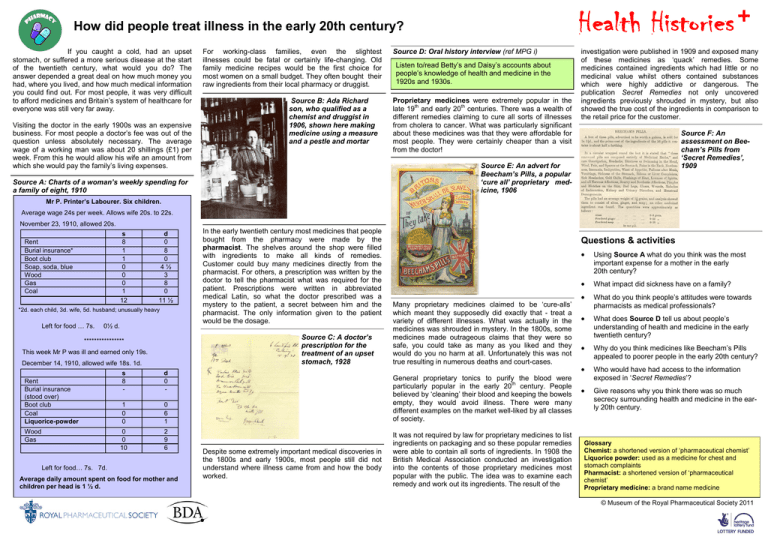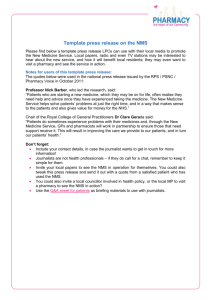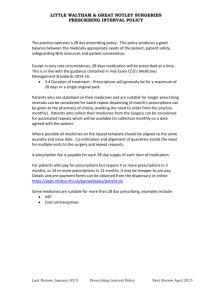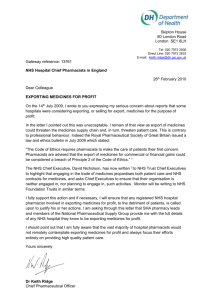How did people treat illness in the early 20th century?
advertisement

How did people treat illness in the early 20th century? If you caught a cold, had an upset stomach, or suffered a more serious disease at the start of the twentieth century, what would you do? The answer depended a great deal on how much money you had, where you lived, and how much medical information you could find out. For most people, it was very difficult to afford medicines and Britain‟s system of healthcare for everyone was still very far away. Visiting the doctor in the early 1900s was an expensive business. For most people a doctor‟s fee was out of the question unless absolutely necessary. The average wage of a working man was about 20 shillings (£1) per week. From this he would allow his wife an amount from which she would pay the family‟s living expenses. For working-class families, even the slightest illnesses could be fatal or certainly life-changing. Old family medicine recipes would be the first choice for most women on a small budget. They often bought their raw ingredients from their local pharmacy or druggist. Source B: Ada Richard son, who qualified as a chemist and druggist in 1906, shown here making medicine using a measure and a pestle and mortar Source D: Oral history interview (ref MPG i) Listen to/read Betty‟s and Daisy‟s accounts about people‟s knowledge of health and medicine in the 1920s and 1930s. Proprietary medicines were extremely popular in the late 19th and early 20th centuries. There was a wealth of different remedies claiming to cure all sorts of illnesses from cholera to cancer. What was particularly significant about these medicines was that they were affordable for most people. They were certainly cheaper than a visit from the doctor! investigation were published in 1909 and exposed many of these medicines as „quack‟ remedies. Some medicines contained ingredients which had little or no medicinal value whilst others contained substances which were highly addictive or dangerous. The publication Secret Remedies not only uncovered ingredients previously shrouded in mystery, but also showed the true cost of the ingredients in comparison to the retail price for the customer. Source F: An assessment on Beecham’s Pills from ‘Secret Remedies’, 1909 Source E: An advert for Beecham’s Pills, a popular ‘cure all’ proprietary medicine, 1906 Source A: Charts of a woman’s weekly spending for a family of eight, 1910 Mr P. Printer’s Labourer. Six children. Average wage 24s per week. Allows wife 20s. to 22s. November 23, 1910, allowed 20s. s 8 1 1 0 0 0 1 12 Rent Burial insurance* Boot club Soap, soda, blue Wood Gas Coal d 0 8 0 4½ 3 8 0 11 ½ *2d. each child, 3d. wife, 5d. husband; unusually heavy Left for food … 7s. 0½ d. Source C: A doctor’s prescription for the treatment of an upset stomach, 1928 **************** This week Mr P was ill and earned only 19s. December 14, 1910, allowed wife 18s. 1d. Rent Burial insurance (stood over) Boot club Coal Liquorice-powder Wood Gas In the early twentieth century most medicines that people bought from the pharmacy were made by the pharmacist. The shelves around the shop were filled with ingredients to make all kinds of remedies. Customer could buy many medicines directly from the pharmacist. For others, a prescription was written by the doctor to tell the pharmacist what was required for the patient. Prescriptions were written in abbreviated medical Latin, so what the doctor prescribed was a mystery to the patient, a secret between him and the pharmacist. The only information given to the patient would be the dosage. s 8 - d 0 - 1 0 0 0 6 1 0 0 10 2 9 6 Left for food… 7s. 7d. Average daily amount spent on food for mother and children per head is 1 ½ d. Questions & activities Many proprietary medicines claimed to be „cure-alls‟ which meant they supposedly did exactly that - treat a variety of different illnesses. What was actually in the medicines was shrouded in mystery. In the 1800s, some medicines made outrageous claims that they were so safe, you could take as many as you liked and they would do you no harm at all. Unfortunately this was not true resulting in numerous deaths and court-cases. General proprietary tonics to purify the blood were particularly popular in the early 20th century. People believed by „cleaning‟ their blood and keeping the bowels empty, they would avoid illness. There were many different examples on the market well-liked by all classes of society. Despite some extremely important medical discoveries in the 1800s and early 1900s, most people still did not understand where illness came from and how the body worked. It was not required by law for proprietary medicines to list ingredients on packaging and so these popular remedies were able to contain all sorts of ingredients. In 1908 the British Medical Association conducted an investigation into the contents of those proprietary medicines most popular with the public. The idea was to examine each remedy and work out its ingredients. The result of the Using Source A what do you think was the most important expense for a mother in the early 20th century? What impact did sickness have on a family? What do you think people‟s attitudes were towards pharmacists as medical professionals? What does Source D tell us about people‟s understanding of health and medicine in the early twentieth century? Why do you think medicines like Beecham‟s Pills appealed to poorer people in the early 20th century? Who would have had access to the information exposed in „Secret Remedies‟? Give reasons why you think there was so much secrecy surrounding health and medicine in the early 20th century. Glossary Chemist: a shortened version of „pharmaceutical chemist‟ Liquorice powder: used as a medicine for chest and stomach complaints Pharmacist: a shortened version of „pharmaceutical chemist‟ Proprietary medicine: a brand name medicine © Museum of the Royal Pharmaceutical Society 2011 Did reforms in the early 20th century have an impact on health? The election of a Liberal government in 1906 saw the introduction of a number of laws which brought about drastic social reform. These included an Education Act of 1906 which allowed local authorities to provide free school meals for the poorest families and the Children and Young Persons Act of 1908 which prosecuted those ill-treating or neglecting children in their care. It also became illegal to sell tobacco and alcohol to children and banned them from working in dangerous trades. The most significant social reform to affect the practice of pharmacy and medicine in Britain was the National Insurance Act of 1911. This entitled poor people earning under £160 a year and under the age of 70, to free healthcare benefits. It was financed by a contribution of 4d for men and 3d for women by their employer, a compulsory 4d from the employee‟s weekly wage and 2d from the state. Before the National Insurance Act, many workers had paid weekly into a „Friendly Society‟ fund; the system was very similar to an insurance policy. The Societies offered sick-pay, old-age pensions and help with funeral expenses among other benefits. There was a doctor employed by each Society who would be paid 4s per year per patient to visit their members and provide medicine to them. Source A: A working man’s spending out of his own pocket-money, kept back from the family expenditure, circa 1913 Mr H: Mail-van driver; Six children Wage, 25s.; allows [his wife] 21s. The penny for the hospital is a very common payment in Lambeth – one which always comes out of the man‟s private purse…[from the family expenses chart] we are able to construct his own private budget of 4s. pocket-money …It must run something like this: s d National Insurance 0 4 Slate Club* 1 2 Hospital 0 1 Tobacco 1 6 Fares 0 11 [* Slate club was a Friendly Society] It was only the wage-earner of the family who could benefit from the new National Insurance Act so their families still depended on the Friendly Societies for assistance with medical care. member of the Pharmaceutical Society. An unqualified chemist or dispenser might well be more appealing to the Friendly Societies as their services would be cheaper. The National Insurance Act of 1911 made a massive impact on the practice of pharmacy. Up to then many doctors had not only prescribed medicines but made up the medicines themselves or had a medicine dispenser working for them. This meant the patient did not need to visit the pharmacist in order to get a prescription made up. With free healthcare available to a large proportion of the population, doctors were now more accessible, and therefore busier than before. It was decided through the new Act that the role of a doctor should be better defined. Source C: Letter to the Pharmaceutical Journal, 27th May 1911 Source E: A pharmacy advertising the dispensing of ‘panel’ prescriptions, 1930s Source B: David Lloyd George, Chancellor of the Exchequer, in a speech to Parliament 4th May 1911 “…the first thing which I think should be done is separate the drugs from the doctors, because a patient, so long as he gets something discoloured and really nasty, is perfectly convinced that it must be a very good medicine….I suggest that there should be a separation of drugs from the doctor whose business should be confined to prescribing. It should be for the chemist to dispense. At any rate, there should be a compulsory separation of the two…” The Act offered many benefits which were already offered by the Friendly Societies and so David Lloyd George proposed that the scheme should directly involve them. He offered government money so that they could extend their services to people who were too poor to join a Friendly Society. Although the Societies were not in complete agreement with the Act, they recognised the privileged position it offered. They were to administer the cash benefits from the scheme (pensions, sick pay etc) as well as control the medical and pharmaceutical services. This last privilege really offended the medical profession. The Act gave the Friendly Societies the rights of the employer over doctors and chemists under their contract, to deliver the new National Scheme. The experience of doctors working for the Societies in the past had been poor pay and inadequate resources. The greatest resentment for the medical professionals was that they would be under the control of a committee of non-medical professionals. Pharmacists had a greater problem. The Act may have stated that “it should be for the chemist to dispense” but it did not specify that the “chemist” had to be formerly qualified and registered in the art of pharmacy, as a Pharmacists petitioned the House of Commons demanding an amendment of the Act to prevent unqualified persons dispensing medicines, both in the public interest and for the sake of their threatened profession. By 1913 when the medical benefits outlined in the Act were finally implemented, the Pharmaceutical Society had managed to secure the exclusive right for qualified pharmacists to dispense doctors‟ prescriptions for those in the National Insurance Scheme. Of course it did not prevent unqualified dispensers from providing medicine for those not in the scheme. Questions & activities Using Source A discuss the priorities of the working man in 1913. Give reasons why mothers, children and the elderly were not eligible to benefit from the National Insurance Scheme. Make a table to show the advantages and disadvantages of the National Health Insurance Scheme for: - the Friendly Societies - doctors - pharmacists - the government Imagine you are a pharmacist in 1911. Write a letter to an MP giving your opinions about the National Insurance Act and the impact it will have on your profession. Do you think the National Insurance Act went far enough to change the lives of the poor in the early twentieth century? Source D: Oral history interview (ref MPG ii) Listen to/read Betty talking about „the panel‟ and the Hospital Saturday Fund. Before 1913 about 90% of all dispensing took place in doctors‟ surgeries. Almost as soon as the Act took effect those pharmacists who had signed up to be on „the panel‟ noticed a difference in the demand for made up prescriptions. The impact differed according to the region. Those working in poorer areas found themselves very busy indeed with some prescription dispensing increasing from one or two, to several hundred per week! The National Health Insurance Scheme became more popular as the century progressed and by 1937 nearly all pharmacists were on „the panel‟. By 1946, two years before the National Health Service was implemented, 77% of all prescriptions dispensed in England were as panel prescriptions. Glossary Chemist: a shortened version of „pharmaceutical chemist‟ Dispenser: somebody who supplies medicines The Panel: the name given to the group of people who administered the National Health Insurance Scheme locally Pharmaceutical Society: the professional body representing pharmacists in Great Britain Pharmacist: a shortened version of „pharmaceutical chemist‟ © Museum of the Royal Pharmaceutical Society 2011 Did the establishment of the National Health Service change pharmacy in Britain? In July 1948 the National Health Service (NHS) was launched under the leadership of the Minister for Health, Aneurin Bevan. For the first time, all healthcare was free – for everyone. The National Health Insurance Scheme had gone so far to improve the health of the working classes, but their dependants still had to pay for treatment. The NHS entitled the elderly, non-working mothers, and children to a healthier and more hopeful future. Research carried out by the Pharmaceutical Journal in the first few years of the NHS showed a direct link between industrial, working class areas and an increase in customer prescriptions. Source C: Table to show prescription dispensing in the year before and in the first year of the NHS Number of NHI prescriptions July 1947 – June 1948 Number of NHS prescriptions July 1948 – June 1949 Aberdeenshire 4519 12,105 a Derbyshire (1) 0 25,300 * b Derbyshire (2) 16,531 65,853 Devon 2335 5475 b East Anglia 7780 25,788 a District Source A: National Health Service leaflets were made available to the public to let them know what the new service would provide Do you prefer NHI (a) or NHS (b)? _ Source D: Pharmacists’ memories of the early days of the NHS Douglas Raven worked in a pharmacy near the Royal Crescent in Bath. “The customers at that time were mainly account customers who...continued to remain private patients and seemed to view the provision of free prescriptions as „not for us‟, an attitude which...disappeared over the months when they realised it was „free for all‟.” Source B: A pharmacist’s memories of the early days of the NHS Edward Walker worked in a pharmacy in a working-class area of Nottingham in 1948 “It was much busier…people couldn‟t quite believe it – getting free medicine. Eventually we had to have a waiting room for patients with prescriptions, just to prevent the shop from getting too overcrowded. We were so busy that we also had to employ a new pharmacist and a new apprentice.” Other pharmacists recalled how 5th July 1948 was no different from any other day and that they were not over-run with prescriptions claiming free medicines. Lancashire 5103 12,866 a Middlesex (1) 13,536 42,037 a Middlesex (2) 14,000 25,868 a Middlesex (3) † 40,094 122,708 a Northumberland 2706 8439 b North Wales 2533 14,518 a South Coast 1200 7177 a Worcestershire (1) 4667 11,551 a Worcestershire (2) 6893 19,833 a Yorkshire 8632 26,855 b Listen to/read Betty‟s and Daisy‟s thoughts on the NHS. “Patients were certainly confused. At first they couldn‟t understand it, although later they did begin to realise just how much they could get free, cotton wool and bandages in particular. There were lots of stories going round that people got them on the NHS and then used them to stuff cushions.” By 1952 the offer of completely free medical care was withdrawn and patients were charged 1 shilling per form. This went up to 1 shilling per item four years later. The National Health Insurance Scheme had changed the practice of pharmacy considerably in the early twentieth century. The NHS did little to change this practice further, but did considerably increase the volume of dispensed prescriptions for some pharmacists. This meant the role of the pharmacist had to adapt. Many created a dedicated dispensing space in their shops, solely for the purpose of making up prescriptions. This separated many pharmacists from their customers and required more staff to manage the shop and offer advice. Source E: A dispensing technician making up a prescription in the dispensary, 1950s * Approximate † More than one business Attitudes from the public were mixed. Whilst some welcomed free medical treatment for all, others particularly the wealthy, were not so keen. Source F: Oral history interview (ref MPG iii) Harold Robinson worked in an independent pharmacy in Cheltenham when the NHS began. NB: ‘Appliances’ refers to dentures and spectacles To be eligible to participate in the new NHS, people had to apply to a NHS doctor of their choice. Every member of the family had to apply individually, parents on behalf of their children. People were encouraged to submit their applications prior to the Scheme‟s start date of 5th July so as to benefit immediately from free healthcare which included prescriptions, hospital services, dentist services, eye care and maternity services. Post-war Britain was entering a new medical era. as medical professionals, through their skills to make medicines for the ill in their shops. With an increased demand for prescriptions, pharmacists had less time to use their skills and knowledge to make up their own remedies, which many felt cheapened the profession. Due to this and because of the great advancements in medicine during the mid twentieth century, pharmaceutical industries began to grow and take over the manufacturing of medicines. The new National Health Service upset many pharmacists. They had worked for years to gain respect Questions & activities Why do you think the NHS was met with such a mixed reaction from the general public? Using Source C, why do you think some pharmacists preferred the National Health Insurance Scheme to the National Health Service? Why do you think a charge per prescription form was introduced in 1952? Why do you think this changed to be a charge per item by 1956? “The popularity of the NHS was directly linked to the aftermath of World War II.” Use the sources and your own historical knowledge to discuss this opinion. Using all the sources, make a table to show the advantages and disadvantages of the National Health Service in its first few years. Hold a hot-seat debate to discuss the views of different people affected by the early years of the NHS. Characters could be: a working class mother, an old aged pensioner, a wealthy businessman, a pharmacist, Aneurin Bevan. Glossary Apprentice: somebody who is trained by a skilled professional in an art, craft or trade Dependants: people who depend on another person, e.g. wife, and children Dispensing: to supply medicines Pharmacist: a shortened version of „pharmaceutical chemist‟ Technician: somebody skilled in practical science © Museum of the Royal Pharmaceutical Society 2011


